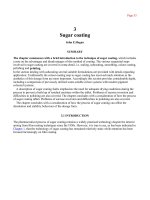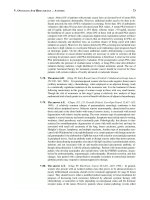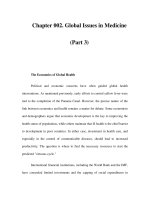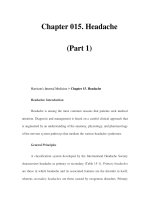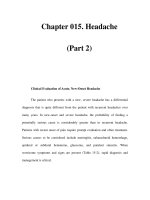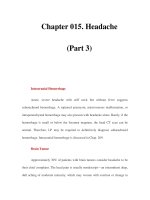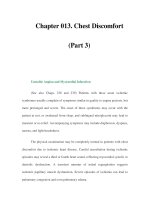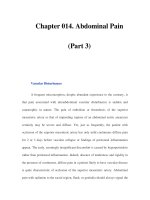Chapter 015. Headache (Part 3) pdf
Bạn đang xem bản rút gọn của tài liệu. Xem và tải ngay bản đầy đủ của tài liệu tại đây (11.76 KB, 5 trang )
Chapter 015. Headache
(Part 3)
Intracranial Hemorrhage
Acute, severe headache with stiff neck but without fever suggests
subarachnoid hemorrhage. A ruptured aneurysm, arteriovenous malformation, or
intraparenchymal hemorrhage may also present with headache alone. Rarely, if the
hemorrhage is small or below the foramen magnum, the head CT scan can be
normal. Therefore, LP may be required to definitively diagnose subarachnoid
hemorrhage. Intracranial hemorrhage is discussed in Chap. 269.
Brain Tumor
Approximately 30% of patients with brain tumors consider headache to be
their chief complaint. The head pain is usually nondescript—an intermittent deep,
dull aching of moderate intensity, which may worsen with exertion or change in
position and may be associated with nausea and vomiting. This pattern of
symptoms results from migraine far more often than from brain tumor. The
headache of brain tumor disturbs sleep in about 10% of patients. Vomiting that
precedes the appearance of headache by weeks is highly characteristic of posterior
fossa brain tumors. A history of amenorrhea or galactorrhea should lead one to
question whether a prolactin-secreting pituitary adenoma (or the polycystic ovary
syndrome) is the source of headache. Headache arising de novo in a patient with
known malignancy suggests either cerebral metastases or carcinomatous
meningitis, or both. Head pain appearing abruptly after bending, lifting, or
coughing can be due to a posterior fossa mass (or a Chiari malformation). Brain
tumors are discussed in Chap. 374.
Temporal Arteritis
(See also Chaps. 29 and 319) Temporal (giant cell) arteritis is an
inflammatory disorder of arteries that frequently involves the extracranial carotid
circulation. It is a common disorder of the elderly; its annual incidence is 77 per
100,000 individuals ages 50 and older. The average age of onset is 70 years, and
women account for 65% of cases. About half of patients with untreated temporal
arteritis develop blindness due to involvement of the ophthalmic artery and its
branches; indeed, the ischemic optic neuropathy induced by giant cell arteritis is
the major cause of rapidly developing bilateral blindness in patients >60 years.
Because treatment with glucocorticoids is effective in preventing this
complication, prompt recognition of the disorder is important.
Typical presenting symptoms include headache, polymyalgia rheumatica
(Chap. 319), jaw claudication, fever, and weight loss. Headache is the dominant
symptom and often appears in association with malaise and muscle aches. Head
pain may be unilateral or bilateral and is located temporally in 50% of patients but
may involve any and all aspects of the cranium. Pain usually appears gradually
over a few hours before peak intensity is reached; occasionally, it is explosive in
onset. The quality of pain is only seldom throbbing; it is almost invariably
described as dull and boring, with superimposed episodic stabbing pains similar to
the sharp pains that appear in migraine. Most patients can recognize that the origin
of their head pain is superficial, external to the skull, rather than originating deep
within the cranium (the pain site for migraineurs). Scalp tenderness is present,
often to a marked degree; brushing the hair or resting the head on a pillow may be
impossible because of pain. Headache is usually worse at night and often
aggravated by exposure to cold. Additional findings may include reddened, tender
nodules or red streaking of the skin overlying the temporal arteries, and tenderness
of the temporal or, less commonly, the occipital arteries.
The erythrocyte sedimentation rate (ESR) is often, though not always,
elevated; a normal ESR does not exclude giant cell arteritis. A temporal artery
biopsy followed by treatment with prednisone 80 mg daily for the first 4–6 weeks
should be initiated when clinical suspicion is high. The prevalence of migraine
among the elderly is substantial, considerably higher than that of giant cell
arteritis. Migraineurs often report amelioration of their headaches with prednisone;
thus, caution must be used when interpreting the therapeutic response.
Glaucoma
Glaucoma may present with a prostrating headache associated with nausea
and vomiting. The headache often starts with severe eye pain. On physical
examination, the eye is often red with a fixed, moderately dilated pupil. Glaucoma
is discussed in Chap. 29.
Primary Headache Syndromes
Primary headaches are disorders in which headache and associated features
occur in the absence of any exogenous cause (Table 15-1). The most common are
migraine, tension-type headache, and cluster headache.
Primary Headache Syndromes
Primary headaches are disorders in which headache and associated features
occur in the absence of any exogenous cause (Table 15-1). The most common are
migraine, tension-type headache, and cluster headache.
